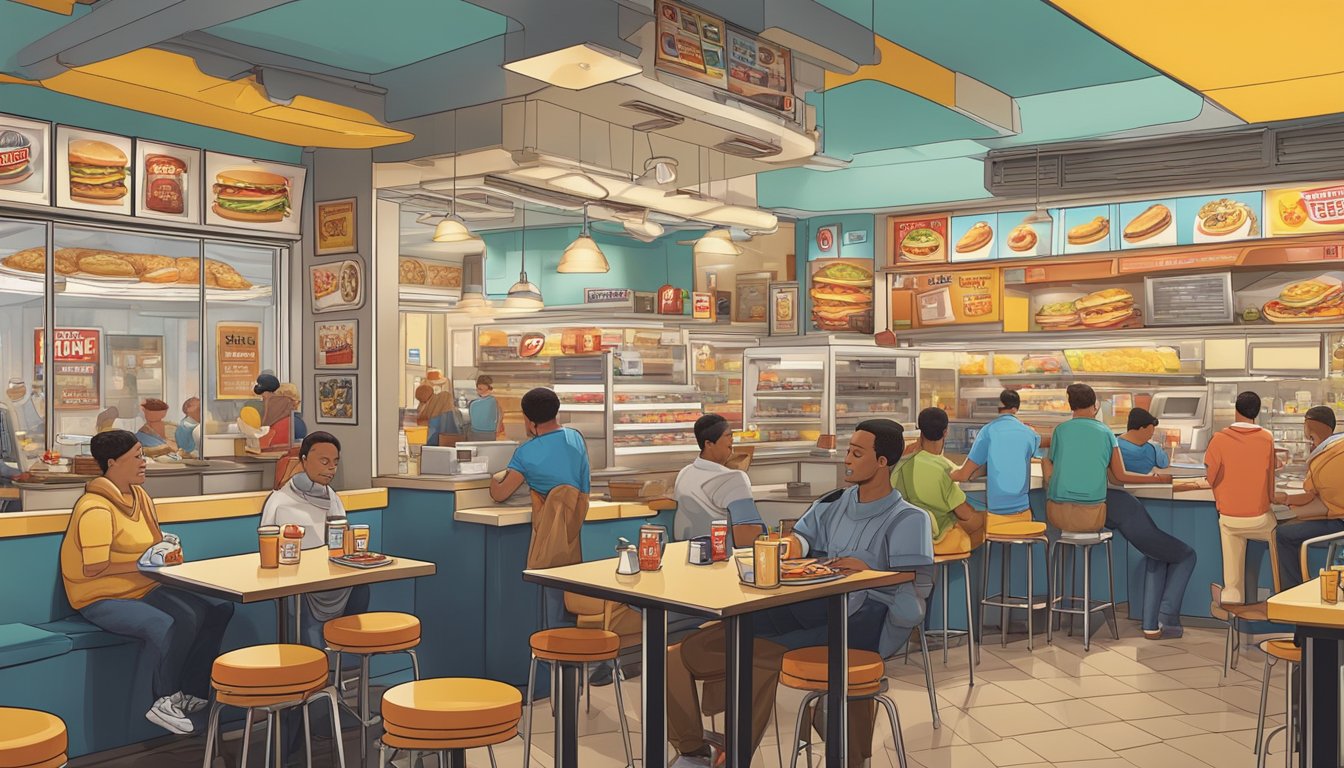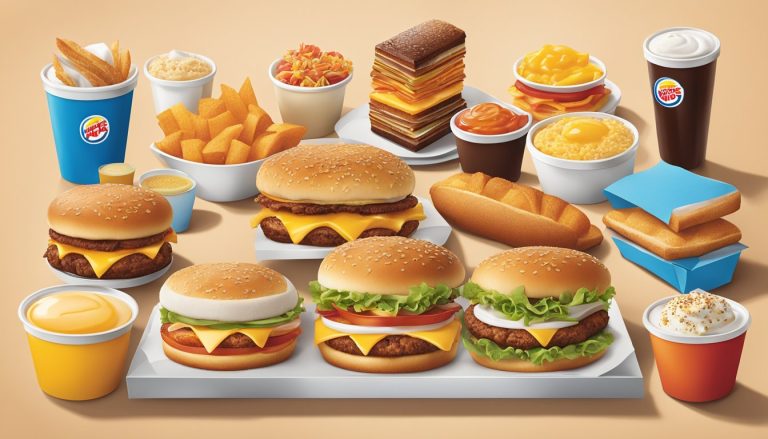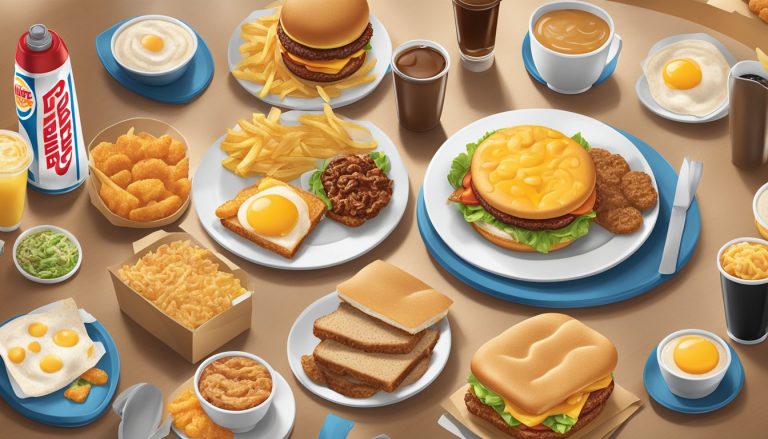Burger King’s breakfast menu has left an indelible mark on American fast food history. Launched in the late 1970s, BK’s morning offerings followed McDonald’s pioneering move into the breakfast market earlier that decade. The introduction of breakfast items by major fast food chains revolutionized morning dining habits across the United States.
This expansion into breakfast service proved to be a game-changer for the industry. By offering morning meals, fast food restaurants were able to extend their operating hours and spread fixed costs over a longer period. The move also tapped into a new customer base of early risers and commuters seeking quick, convenient breakfast options.
BK’s breakfast menu has evolved over the years, adapting to changing consumer tastes and preferences. While initially trailing behind its competitors, Burger King’s breakfast offerings have become an integral part of its brand identity and continue to play a significant role in the company’s overall strategy. The legacy of BK’s breakfast extends beyond mere menu items, reflecting broader shifts in American eating habits and the fast food landscape.
Origins and Founding of Burger King
Burger King‘s roots trace back to the early 1950s in Florida. The fast food chain emerged from humble beginnings to become a global brand, shaped by entrepreneurial vision and innovative thinking.
Insta-Burger King and the Birth of a Franchise
In 1953, Keith J. Kramer and Matthew Burns founded Insta-Burger King in Jacksonville, Florida. Their concept was inspired by the McDonald brothers’ successful operation in California. The original restaurant featured a unique cooking device called an Insta-Broiler, which quickly prepared burgers.
The Insta-Burger King name reflected the speed of service. Despite initial success, the company faced financial difficulties. This opened the door for new leadership to step in and transform the brand.
Founders James McLamore and David Edgerton
James McLamore and David Edgerton saw potential in the Insta-Burger King concept. In 1954, they purchased a franchise in Miami, Florida. The duo soon acquired the rights to the entire chain.
McLamore and Edgerton rebranded the company as Burger King Corporation in 1955. They introduced innovations like the flame broiler and created the iconic Whopper sandwich in 1957.
The founders focused on expanding through franchising. Their efforts led to rapid growth across Florida and beyond. By 1967, Burger King had become a major player in the fast food industry.
Brand Evolution and Menu Development
Burger King’s journey from a simple burger joint to a global fast-food powerhouse is marked by strategic menu expansions and iconic product launches. These innovations shaped the brand’s identity and helped it compete in the crowded fast-food marketplace.
The Introduction of the Whopper
The Whopper, introduced in 1957, became Burger King’s signature sandwich and a cornerstone of its brand identity. This flame-grilled quarter-pound beef patty topped with tomatoes, lettuce, mayonnaise, pickles, and onions on a sesame seed bun set BK apart from competitors.
The Whopper’s success led to numerous variations over the years, including the Whopper Jr., Angry Whopper, and plant-based Impossible Whopper. These iterations kept the flagship product fresh and appealing to changing consumer tastes.
Expanding the Menu Beyond Burgers
Burger King diversified its menu to appeal to a broader customer base. In the 1970s, BK introduced French fries as a side option, quickly becoming a staple alongside burgers.
Chicken products joined the lineup in the 1980s, with offerings like the Original Chicken Sandwich and chicken nuggets. This expansion allowed BK to compete with other fast-food chains branching out beyond beef.
Desserts and drinks also saw significant development:
- Soft-serve ice cream
- Milkshakes
- Specialty coffees
- A variety of soft drinks
Breakfast Revolution and Key Items
Burger King entered the breakfast market in 1979, recognizing the potential for increased sales and customer loyalty. The breakfast menu became a crucial part of BK’s strategy to boost store traffic during traditionally slow morning hours.
Key breakfast items include:
- Croissan’wich (1983): A croissant-based breakfast sandwich
- French Toast Sticks (1985): A portable, sweet breakfast option
- Enormous Omelet Sandwich (2005): A hearty breakfast offering
These items, especially the Croissan’wich, helped establish Burger King as a serious contender in the fast-food breakfast market. The chain continues to innovate its breakfast menu, adapting to changing consumer preferences and dietary trends.
Growth and Challenges

Burger King’s breakfast menu expansion coincided with significant corporate changes. The company faced both opportunities and obstacles as it grew its morning offerings nationwide.
National Expansion and Franchising
Burger King rapidly expanded its breakfast menu across the United States through its franchise system. Franchise owners played a key role in rolling out new breakfast items and adapting to local tastes. The company provided franchise agreements that included specific requirements for breakfast service hours and menu offerings.
Burger King Corporation supported franchisees with national advertising campaigns promoting breakfast. This helped establish BK as a morning destination alongside competitors like McDonald’s. By the 1980s, breakfast had become a significant revenue stream for many Burger King locations.
Financial Difficulties and Corporate Restructuring
Despite breakfast success, Burger King faced financial challenges in the 1980s and 1990s. The Pillsbury Company, which had acquired BK in 1967, struggled to manage the fast-food chain effectively. This led to a series of ownership changes.
Grand Metropolitan purchased Pillsbury in 1988, taking control of Burger King. The new owners initiated restructuring efforts to improve profitability. These changes impacted breakfast operations, with some menu adjustments and cost-cutting measures implemented.
In 1997, Grand Metropolitan merged with Guinness to form Diageo. Burger King’s performance continued to lag under Diageo’s ownership.
Mergers and Acquisitions
Burger King changed hands several times in the 2000s, affecting its breakfast strategy. In 2002, TPG Capital led a group of investors in purchasing BK from Diageo for $1.5 billion.
The TPG era saw renewed focus on breakfast innovation. Burger King introduced new items and marketing campaigns to compete in the morning daypart.
In 2010, 3G Capital acquired Burger King for $3.26 billion. This Brazilian investment firm emphasized cost reduction and efficiency. Breakfast remained a priority, but with a streamlined approach.
The most recent major change came in 2014 when Burger King merged with Tim Hortons to form Restaurant Brands International. This union combined BK’s breakfast expertise with Tim Hortons’ coffee and bakery strengths.
Marketing and Advertising Strategies

Burger King’s marketing efforts have focused on personalization, breakfast offerings, and innovative campaigns to capture consumer attention and drive sales growth. These strategies have helped shape BK’s identity in the competitive fast food landscape.
The ‘Have It Your Way’ Campaign
Burger King’s iconic “Have It Your Way” slogan debuted in 1974, emphasizing customization and customer choice. This campaign positioned BK as a flexible alternative to competitors’ standardized menus. Television commercials featured catchy jingles and visuals of customers personalizing their orders. The slogan resonated with consumers, becoming a cornerstone of BK’s brand identity for decades.
In 2014, BK updated the slogan to “Be Your Way,” maintaining the spirit of individuality while adapting to changing consumer values. This evolution aimed to connect with younger audiences seeking self-expression and authenticity in their brand interactions.
Targeting the Breakfast Market
Burger King entered the breakfast market in the 1970s, recognizing the growing demand for convenient morning meals. The chain introduced items like breakfast sandwiches and hash browns to compete with established players. BK’s breakfast menu expanded over time, incorporating options like French toast sticks and breakfast burritos.
Marketing efforts for breakfast items often highlighted convenience and value. Campaigns featured early-morning workers and busy families to showcase BK as a quick, tasty breakfast solution. The company also experimented with extended breakfast hours to capture late-morning customers.
Innovative Concepts and Advertising Campaigns
Burger King has launched several attention-grabbing campaigns to stand out in the crowded fast food market. The BK Whopper Bar concept, introduced in 2009, offered a premium burger experience with customizable toppings and open kitchen designs. This initiative aimed to elevate the brand’s image and attract a more upscale clientele.
In 2019, BK made headlines with the Impossible Whopper, a plant-based burger option. The launch was supported by a “Impossible Taste Test” campaign, challenging customers to distinguish between the plant-based and beef versions. This move positioned BK as an innovator in the growing plant-based food trend.
Digital marketing has become increasingly important for BK. The company has leveraged social media platforms for viral campaigns, interactive promotions, and real-time engagement with customers. These efforts have helped BK maintain relevance and connect with younger demographics in the digital age.
Comparative Analysis with Competitors

Burger King’s breakfast offerings ignited fierce competition in the fast food industry. Rival chains scrambled to capture market share in the morning meal segment, leading to innovative menu items and marketing strategies.
Burger Wars: McDonald’s vs. Burger King
McDonald’s and Burger King emerged as the primary contenders in the breakfast battle. McDonald’s introduced its Egg McMuffin in 1972, gaining an early advantage. Burger King countered with the Croissan’wich in 1983, featuring a flaky croissant bun.
The two chains engaged in aggressive advertising campaigns, each claiming superiority in taste and quality. McDonald’s emphasized its fresh-cracked eggs, while Burger King touted its flame-grilled patties.
Menu diversity became a key differentiator. McDonald’s offered a wider range of breakfast options, including hotcakes and McGriddles. Burger King focused on sandwich variations and value deals to attract cost-conscious consumers.
Wendy’s and Other Rivals in the Breakfast Segment
Wendy’s entered the breakfast market later, launching its morning menu nationwide in 2020. The chain differentiated itself with unique items like the Breakfast Baconator and Frosty-ccino.
Jack in the Box, an early breakfast pioneer, maintained a strong presence with its diverse all-day breakfast menu. The chain’s breakfast burritos and croissant sandwiches provided stiff competition in certain regions.
Regional players like Hardee’s and Carl’s Jr. carved out niches with hearty offerings such as biscuit sandwiches and breakfast platters. These chains often targeted specific demographics with larger portion sizes and bold flavors.
Taco Bell disrupted the traditional breakfast landscape by introducing Mexican-inspired morning items, appealing to younger consumers seeking alternatives to standard egg sandwiches.
Influence and Cultural Impact

Burger King’s breakfast menu has left an indelible mark on American fast-food culture, shaping eating habits and influencing competitors. Its impact extends beyond U.S. borders, adapting to diverse tastes globally while responding to changing health trends.
Global Expansion and Regional Tastes
Burger King’s breakfast offerings have expanded internationally, reaching over 100 countries. The chain tailors its menu to local preferences in different regions. In the UK, BK serves a full English breakfast with beans and grilled tomatoes. Middle Eastern locations offer falafel wraps as morning options.
In Latin America, Burger King incorporates local flavors like dulce de leche-filled croissants in Argentina. Asian markets feature congee and steamed buns in select locations. This adaptability has helped BK establish a strong global breakfast presence.
BK’s Role in American Fast-Food Culture
Burger King’s breakfast menu has become a staple in American fast-food culture since its 1979 introduction. The Croissan’wich, launched in 1983, popularized breakfast sandwiches as a convenient morning meal option.
BK’s breakfast hours, typically ending at 10:30 AM, created a sense of urgency and exclusivity around morning offerings. This time limit became a cultural touchstone, inspiring marketing campaigns and social media discussions.
The chain’s breakfast innovations have pushed competitors to expand their own morning menus, driving industry-wide growth in the breakfast segment.
Health Trends and Menu Adaptations
Responding to health-conscious consumers, Burger King has introduced lighter breakfast options. In 2015, they added oatmeal to the menu, providing a whole-grain alternative to traditional fast-food fare.
BK has also adjusted portion sizes, offering smaller breakfast sandwiches and wraps. They’ve introduced turkey sausage as a leaner protein option and egg whites for lower-calorie choices.
Nutritional information is now prominently displayed, allowing customers to make informed decisions. These adaptations reflect broader health trends in the fast-food industry, balancing indulgence with healthier alternatives.
Operational Dynamics
Burger King’s breakfast menu launch brought significant changes to its operational dynamics. These shifts impacted supply chains, franchise relationships, and financial performance.
Supply Chain Management
BK expanded its supplier network to accommodate breakfast ingredients. New partnerships formed with egg and dairy producers. Existing meat suppliers increased production to meet demand for breakfast sausage and bacon.
Distribution centers adapted schedules for early morning deliveries. Restaurants installed specialized equipment like griddles and toasters. BK’s corporate team developed training programs for franchisees on breakfast prep and service.
Franchise vs. Corporate Locations
Breakfast rollout varied between franchise and corporate-owned locations. Corporate stores piloted the menu, refining processes before wider implementation. Franchisees received support packages with marketing materials and equipment recommendations.
Some franchise owners hesitated due to initial costs. BK offered financial incentives to encourage adoption. Corporate locations saw quicker breakfast sales growth initially. Franchisees caught up as best practices spread through the network.
Investments and Financial Performance
Breakfast introduction required significant capital investment. RBI, BK’s parent company, allocated funds for equipment upgrades and marketing campaigns. Initial sales were modest but grew steadily.
By 2010, breakfast accounted for 12% of BK’s total sales. Profit margins on breakfast items typically exceeded those of lunch and dinner. This boosted overall financial performance, attracting new investors.
BK’s stock price rose 15% in the year following full breakfast rollout. Analysts cited the menu expansion as a key factor in improved earnings reports. The success of breakfast influenced future menu development strategies.
Legal and Ownership Transitions

Burger King’s corporate history involves complex ownership changes and financial maneuvers. These transitions shaped the company’s global expansion and business strategies.
IPOs and Ownership Changes
Pillsbury Company acquired Burger King in 1967, ushering in a period of rapid growth. Grand Metropolitan purchased Pillsbury in 1989, bringing BK under its umbrella. The 1997 merger between Grand Metropolitan and Guinness created Diageo, which then owned Burger King.
In 2002, Diageo sold BK to a consortium led by TPG Capital for $1.5 billion. The chain went public in 2006 with an IPO on the New York Stock Exchange. 3G Capital took Burger King private again in 2010 in a $3.26 billion deal.
A 2014 merger with Tim Hortons created Restaurant Brands International. 3G Capital retained majority control of the new entity.
Tax Inversions and International Law
The 2014 Burger King-Tim Hortons merger was structured as a tax inversion. This controversial practice involved moving BK’s headquarters to Canada to benefit from lower corporate tax rates.
The deal faced scrutiny from U.S. lawmakers and tax authorities. It sparked debates on corporate tax avoidance and led to tightened regulations on inversions.
Restaurant Brands International maintained dual headquarters in Miami and Toronto. This structure allowed the company to navigate complex international tax laws while preserving operational efficiencies.
Timeline of Significant Milestones

Burger King’s journey through fast food history is marked by key events and strategic decisions. These milestones shaped the company’s growth and impact on the American fast food landscape.
Key Dates in Burger King’s History
Burger King’s story begins in 1953 with the founding of Insta-Burger King in Jacksonville, Florida. In 1954, James McLamore and David Edgerton opened the first Burger King franchise in Miami.
The introduction of the Whopper in 1957 was a pivotal moment, establishing Burger King’s signature sandwich.
In 1959, McLamore and Edgerton purchased the Insta-Burger King franchise, setting the stage for expansion.
Burger King aired its first TV ad in 1958, marking a significant step in marketing.
Historical Analysis of Market Growth
Burger King’s market growth accelerated in the 1970s and 1980s. The company expanded its menu offerings, introducing items like the Original Chicken Sandwich.
Breakfast became a key focus for fast food chains in the 1970s. McDonald’s success with breakfast offerings prompted Burger King to develop its own morning menu.
By expanding operating hours and spreading fixed costs, breakfast service boosted profitability for fast food restaurants. This strategy helped Burger King compete in the evolving fast food landscape.
Burger King’s international expansion began in the 1960s, with locations opening in Puerto Rico and Canada. This global growth continued throughout subsequent decades.




